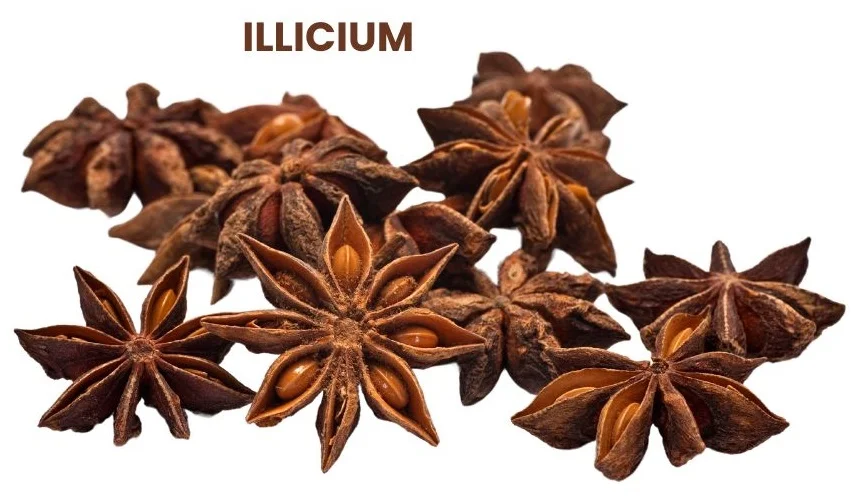Illicium, also known as Anisum Stellatum or Star Anise, is a powerful homeopathic remedy known for its effectiveness in treating digestive and respiratory ailments.
It is especially beneficial for flatulence, colic, chronic cough, and conditions like purulent catarrh.
Illicium is commonly used to relieve gas, three-months’ colic in infants, and respiratory discomfort in the elderly.
With its natural origin from the Illicium verum plant, this remedy is highly effective in addressing digestive disturbances, respiratory infections, and convulsive symptoms.
Its homeopathic use focuses on gentle yet potent healing, making it a popular choice in holistic medicine.

SOURCE INFORMATION
Scientific Classification
- Common Name: Star Anise
- Botanical Name: Illicium verum
- Family: Schisandraceae (formerly classified in the Magnoliaceae family)
- Origin: Native to Southeast Asia, particularly in southern China and Vietnam.
Historical Facts
- Illicium, commonly known as Star Anise, has been historically used for its aromatic seeds and medicinal properties, dating back to ancient Chinese and Ayurvedic medicine.
- It has been prized for its digestive benefits, particularly in treating flatulence, colic, and digestive disturbances.
- The essential oil extracted from the seeds has also been used in traditional medicine for respiratory issues.
- In homeopathy, Anisum Stellatum is remembered for its effects on the digestive system and respiratory ailments, especially in cases of flatulence and chronic cough in elderly or debilitated individuals.
DRUG PATHOGENESIS
- Anisum Stellatum acts primarily on the gastrointestinal and respiratory systems, with a notable effect on flatulence and colic.
- It helps relieve pain localized near the third intercostal cartilage (around the third rib), a symptom often seen in chronic respiratory and digestive ailments.
- It is also used in convulsive states such as vomiting accompanied by epileptiform convulsions.
PHYSICAL CONSTITUTION
- This remedy is suited to individuals with a tendency to suffer from chronic digestive and respiratory complaints, often associated with gas, colic, and catarrhal conditions.
- It is especially suited to people who may experience epileptic fits, flatulence, and colic regularly.
WHAT IS CONSTITUTION IN HOMOEOPATHY?
DIATHESIS
- Gastric diathesis: Tendency towards frequent gas, indigestion, and intestinal pain.
- Respiratory diathesis: Tendency towards catarrhal conditions, with mucus accumulation and chronic cough.
WHAT IS DIATHESIS IN HOMOEOPATHY?
TEMPERAMENT
- The remedy is best suited to individuals with a nervous temperament who tend to be anxious, restless, and easily irritated by physical discomfort, particularly digestive issues.
- These individuals are also prone to colic and flatulence that may lead to a sense of discomfort or anxiety.
WHAT ARE TEMPERAMENTS IN HOMOEOPATHY?
KEY CHARACTERISTICS
- Pain near the Third Rib: Pain typically occurs about one to two inches from the sternum, generally on the right side, but occasionally on the left.
- This is often linked to chronic respiratory or digestive issues.
- Flatulence and Colic: Particularly useful for infantile three-months’ colic where symptoms recur regularly.
- Also indicated for adults with excessive rumbling and gas in the abdomen.
- Cough with Purulent Phlegm: Often seen in old asthmatics and chronic catarrh sufferers, especially in gastric and tracheal catarrh associated with alcoholism.
- Epileptiform Convulsions: In cases of vomiting accompanied by seizures with tongue biting.
- Dyspnea: Shortness of breath, particularly in old asthmatics with accompanying cough and phlegm.
- Purulent Catarrh: Thick, pus-like mucus, particularly in the respiratory tract, often seen in chronic respiratory disorders.
- Haemoptysis: Coughing up blood-streaked mucus, especially in severe cases of chronic lung disease.
- Burning and Numbness of Lips: Often experienced in the inner lower lip alongside sharp pain beneath the lip, a symptom related to acute catarrh.
DETAILED ORGAN SYMPTOMS
NOSE AND RESPIRATORY SYSTEM
- Sharp Stitches: Beneath the lip, indicative of acute catarrh.
- Dyspnea: Difficulty breathing, often seen in older individuals with chronic respiratory conditions.
- Purulent Cough: A productive cough with pus-like mucus in chronic respiratory issues such as asthma and gastric catarrh.
- Haemoptysis: Coughing up blood, a serious condition often linked to chronic lung disease.
DIGESTIVE SYSTEM
- Flatulence: Excessive gas and rumbling in the abdomen, particularly linked to colic and digestive disturbances.
- Three-months’ Colic: Particularly effective for infantile colic where the condition recurs at regular hours.
NERVOUS SYSTEM
- Epileptiform Convulsions: Seizures with biting of the tongue following episodes of vomiting.
CARDIOVASCULAR SYSTEM
- Palpitation: Sensation of irregular heartbeat sometimes accompanied by mouth ulcers (aphthae).
MODALITIES
- Worse: Symptoms worsen after eating, particularly in catarrhal conditions of the elderly and during colic episodes.
- Better: Symptoms improve after passing gas and after digestive issues are addressed.
WHAT ARE MODALITIES IN HOMOEOPATHY?
RELATIONSHIP WITH OTHER DRUGS
Antidote: Nux Vomica is often used to counteract the overuse or side effects of Anisum Stellatum, particularly in cases of gastric irritability.
Complementary Remedies
- Carbo Vegetabilis (for flatulence),
- Antimonium Tartaricum (for respiratory issues with thick mucus),
- Nux Vomica (for digestive complaints associated with alcohol abuse).
DOSAGE
- The third potency (3rd) is generally used for chronic digestive and respiratory complaints.
- Higher potencies may be indicated for more specific symptoms such as colic or flatulence.
Frequently Asked Questions
What are the primary conditions treated by Anisum Stellatum?
- It is primarily used for treating infantile colic, flatulence, chronic cough in asthmatic individuals, and purulent catarrh.
What is the most distinguishing symptom of Anisum Stellatum?
- The most specific symptom is pain near the third rib, usually felt an inch or two from the sternum, especially in patients with chronic cough or gastric issues.
Can Anisum Stellatum be used for acute cases?
- Yes, it is effective in managing acute catarrh, dyspnea in old asthmatics, and infant colic.
Glossary of Terms
- Flatulence: Accumulation of gas in the digestive system.
- Colic: Severe abdominal pain, often seen in infants.
- Purulent: Producing or containing pus.
- Catarrh: Excessive mucus production, especially in the nose or throat.
- Dyspnea: Shortness of breath or difficulty breathing.
- Haemoptysis: Coughing up blood.
- Epileptiform Convulsions: Seizure-like activity resembling epilepsy.
- Intercostal Cartilage: Cartilage located between the ribs.
- Aphthae: Small ulcers in the mouth.
